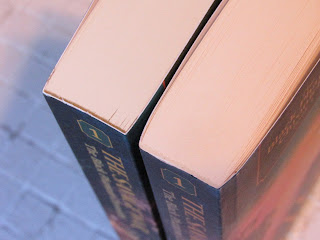Amazon Printing Vrs. Ingram
Most artists know that a printer is just as vital as a piece of art itself. I have certainly been caught a few times by printing something myself to make sure it prints right and then find that another printer somewhere else has destroyed that same exact picture. Most of the time, at Staples, I pass it off as the workers not knowing what they're doing, but for more official printers, that shouldn't be an issue... shouldn't.
For authors, why does this matter? Well, it could mean quite a few things for your book if you're self-publishing. Here are some differences between the Amazon printing and the Ingram printing that might help.
BINDING: Amazon tends to use a dark glue in their binding, (As seen on left). That same glue is just a bit wider than the line of glue Ingram uses, thereby creating a sharper, more square fold.
COLOR: Ingram prints everything a slightly darker shade than what will show up on a computer screen. Amazon prints the same cover more gray and paler. (Once again, Amazon's print is on the left, and Ingram's is on the right. In my picture, the difference is not so noticeable, but it is there, particularly on the upper half of the image.)
TEXTURE: I have found that Ingram's covers and pages are slightly softer to the touch. There is a coarseness with Amazon's that I sometimes like and sometimes don't. It depends on the time.
PRINTER'S MARKS: This is just an observation, and has nothing at all to do about quality. If you ever want to know which printer printed a book you find before you, the image on the left is classic Amazon, and the one on the right is Ingram's. One nice thing about Amazon's is that years later, you will be able to look back and know what day your copy was printed without having to go to any site. This could tell you how valuable your copy is ;)
If you know of anything else, please share. I hope you find this useful information.
(This post was purely about some things that I don't think are often mentioned when discussing the two printers. Such things as price differences and the ability to return books or not, I assume are widely discussed. However, there is an excellent comment on those very things by Mark Dressler below.)




My books are available from both Amazon and Ingram. I have not seen enough difference in quality to make me unhappy. The biggest difference is price. I sold 1200 books last year at various events. I had only one order from INGRAM. WHY? PRICE. On an apples to apples cost basis, an order of 50 books including shipping --from AMAZON was $238.50 ($4.77) per book. The same 50 book order from INGRAM including shipping was $311.48 ($6.11) per book. Multiplying my costs and sales - If all books were ordered from AMAZON my cost would have been $5,724. The INGRAM equivalent cost would have been $7,464. MY net sales would have suffered by $1,740. Turning to shipping however, I haven't figured out how AMAZON decides to ship books. I have received partial orders in 17 different envelopes (1 book in each and then a box with the remainder). No matter how many I order, there is always a straggler or two. Haven't had this experience with INGRAM...But I only order from them on rare occasions. In case authors do not know why INGRAM is important...You can make your books returnable. That's important because book stores will only order books if they are returnable. AMAZON does not allow books to be returned.
ReplyDelete